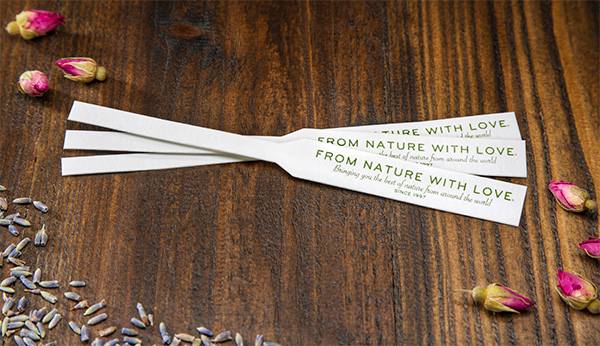|
|
How to Best Assess the Aroma of a Liquid AromaticIt's perfectly natural to want to sniff an essential oil, CO2 extract, absolute, fragrance oil or other fluid aromatic directly from the bottle. We certainly do that anytime we want a general idea of how an aromatic smells. However, basing your assessment of an aromatic strictly by how it smells out of the bottle can be problematic. When you inhale the oil directly from the bottle, the thin bottle neck can prevent the aroma from fully divulging its complexity and its full palette of aromatic notes. Additionally, oil that collects near the opening of the bottle can differ in aroma due to the increased risk of oxidation that occurs when the oil is exposed to air. Additionally, if any other aromatic substance has come in contact with the bottle or the label on the bottle, that aromatic residue can potentially interfere with your ability to accurately assess the aroma of the aromatic inside the bottle. For example, if you are working with several bottles of essential oil, it's possible that a little bit of an essential oil can accidentally get onto your fingertip(s). And as we know, most essential oils are incredibly aromatic. If you then touch the outside of a different bottle of essential oil, you can inadvertently impart the aroma of the other essential oil onto the bottle, label or cap of the oil that you are currently working with. We've seen this happen on multiple occasions, and it can certainly be problematic when trying to accurately assess an aroma. Fragrance Testing Strips
Fragrance testing strips are strips of thick, odorless paper that are ideally suited for evaluating the aroma of essential oils, CO2 extracts, absolutes, fragrance oils and other aromatics. They're also wonderful for evaluating blends and fragrances that you create for personal care or aromatherapy formulations. Using a test strip allows you to assess the aroma immediately after the aromatic is applied to the strip. It also allows you to assess the aroma periodically during the evaporation process so that you can evaluate how it changes over time. As an aromatic "dries out," the top notes fade, then the middle notes, and then the base notes. By using fragrance test strips you can study the aroma immediately after application and then see how the aroma changes after 5 minutes, 15 minutes, 30 minutes and even after several hours or a day have passed. How to Use Fragrance Testing Strips
To use a fragrance testing strip, simply apply 1-2 drops of your aromatic directly onto the strip using a dropper and sniff the strip. Alternatively, the thin end of the test strip can be dipped directly into a bottle that does not have a dropper insert inside. Use care to ensure that the portion of the strip that contains your aromatic does not come into direct contact with your skin, unless you're working with a sufficiently diluted aromatic. Some essential oils and other aromatics are highly concentrated and have the potential of causing skin irritation when applied undiluted to the skin. If you are testing multiple aromatics at once, you can easily jot down the name of each aromatic on strips.Storing Fragrance Testing StripsFragrance Testing Strips are made of a thick, absorbent paper. Store them in the bag that they came in, and keep them stored away from aromatics or anything fragrant/odorous that could impart its scent to all of your strips. Where to Purchase Fragrance Testing StripsWe are pleased to now offer convenient packages of From Nature With Love Fragrance and Perfume Testing Strips for sale. |
